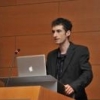Maybe this movie can be remade without the errors concerning the mechanism.

Youtube movie on the mitochondria research
#1
Posted 19 September 2010 - 05:56 AM
Maybe this movie can be remade without the errors concerning the mechanism.
#2
Posted 19 September 2010 - 11:41 AM
#3
Posted 19 September 2010 - 05:49 PM
Sven: you could post a video response.
Nope, it's better to make a new one and delete the old one. Otherwise it seems like the Institute is getting the science wrong.
#4
Posted 19 September 2010 - 06:17 PM
I agree. We have plenty of scientific expertise here, and we should present it properly. I think a video's a great idea; maybe a script would be a good approach.Nope, it's better to make a new one and delete the old one. Otherwise it seems like the Institute is getting the science wrong.Sven: you could post a video response.
#5
Posted 20 September 2010 - 12:46 AM
#6
Posted 20 September 2010 - 05:37 AM
http://www.youtube.com/watch?v=PzihoRsVH-k&feature=channel
Maybe this movie can be remade without the errors concerning the mechanism.
Urg, I'm going to slap myself.
I told BP that the video was okay to post but I didn't really take the time to closely examine the science part of it. I apologize for this.
It would have been better to say that the electrons from the electron transport chain in the mitochondria sometimes go astray and lead to the formation of free radicals (Reactive Oxygen Species - ROS). What the mitochondrial uncoupling project aims to do is reduce the formation of ROS at the site of mitochondria. If chemical uncoupling works in this regard, we can examine mtDNA damage to see if that is reduced as well. Most interestingly, we can look for an increase in lifespan in C. Elegans, and ask whether or not that increase is a result of the reduction of mtDNA damage.
Again, apologies to BP and the rest; I really should have looked more closely.
#7
Posted 20 September 2010 - 04:05 PM
#8
Posted 21 September 2010 - 09:09 PM
#9
Posted 27 September 2010 - 02:55 PM
the mitchondria are forced to fight to survive. If mitchondria were damaged they would create good mitochondria again by having sex with each other (fusion) and creating offspring (fission)
0 user(s) are reading this topic
0 members, 0 guests, 0 anonymous users












































